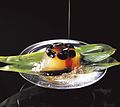Kudzu
Kudzu is a group of climbing, coiling, and trailing perennial vines native to much of East Asia, Southeast Asia, and some Pacific islands. The name is derived from the Japanese name for the plants, kuzu (クズ or 葛), which was written "kudzu" in historical romanizations. Where these plants are naturalized, they can be invasive and are considered noxious weeds. The plant climbs over trees or shrubs and grows so rapidly that it kills them by heavy shading. The plant is edible, but often sprayed with herbicides.
Taxonomy[edit]
Kudzu belongs to the pea family, Fabaceae. It comprises 17 species of plants, which are commonly referred to as kudzu. The genus was first described by the French botanist, Augustin Pyramus de Candolle in 1825. The name "Pueraria" is derived from the Swiss Professor M. N. Puerari.
Description[edit]
Kudzu vines are deciduous, high-climbing, coiling, and trailing. They can reach lengths of up to 20 m. The leaves are alternate and compound, with large and broad leaflets. The flowers are purple, highly fragrant, and occur in long racemes. The fruit is a flat, brown, hairy pod, with 10 seeds.
Distribution and habitat[edit]
Kudzu is native to East Asia, Southeast Asia, and some Pacific islands. It has been introduced to other parts of the world, including North America, where it has become an invasive species.
Uses[edit]
Kudzu has been used for centuries in East Asia for its medicinal properties. It is also used in traditional Chinese medicine. The roots contain starch, which can be used in cooking. The leaves and vines can be used for basketry.
Invasive species[edit]
In areas where kudzu has been introduced, it can become a serious invasive species. It grows rapidly, covering other plants and trees and killing them by heavy shading. Control methods include physical removal, use of herbicides, and biological control.
See also[edit]
Ad. Transform your life with W8MD's Budget GLP-1 injections from $75


W8MD offers a medical weight loss program to lose weight in Philadelphia. Our physician-supervised medical weight loss provides:
- Weight loss injections in NYC (generic and brand names):
- Zepbound / Mounjaro, Wegovy / Ozempic, Saxenda
- Most insurances accepted or discounted self-pay rates. We will obtain insurance prior authorizations if needed.
- Generic GLP1 weight loss injections from $75 for the starting dose.
- Also offer prescription weight loss medications including Phentermine, Qsymia, Diethylpropion, Contrave etc.
NYC weight loss doctor appointmentsNYC weight loss doctor appointments
Start your NYC weight loss journey today at our NYC medical weight loss and Philadelphia medical weight loss clinics.
- Call 718-946-5500 to lose weight in NYC or for medical weight loss in Philadelphia 215-676-2334.
- Tags:NYC medical weight loss, Philadelphia lose weight Zepbound NYC, Budget GLP1 weight loss injections, Wegovy Philadelphia, Wegovy NYC, Philadelphia medical weight loss, Brookly weight loss and Wegovy NYC
|
WikiMD's Wellness Encyclopedia |
| Let Food Be Thy Medicine Medicine Thy Food - Hippocrates |
Medical Disclaimer: WikiMD is not a substitute for professional medical advice. The information on WikiMD is provided as an information resource only, may be incorrect, outdated or misleading, and is not to be used or relied on for any diagnostic or treatment purposes. Please consult your health care provider before making any healthcare decisions or for guidance about a specific medical condition. WikiMD expressly disclaims responsibility, and shall have no liability, for any damages, loss, injury, or liability whatsoever suffered as a result of your reliance on the information contained in this site. By visiting this site you agree to the foregoing terms and conditions, which may from time to time be changed or supplemented by WikiMD. If you do not agree to the foregoing terms and conditions, you should not enter or use this site. See full disclaimer.
Credits:Most images are courtesy of Wikimedia commons, and templates, categories Wikipedia, licensed under CC BY SA or similar.
Translate this page: - East Asian
中文,
日本,
한국어,
South Asian
हिन्दी,
தமிழ்,
తెలుగు,
Urdu,
ಕನ್ನಡ,
Southeast Asian
Indonesian,
Vietnamese,
Thai,
မြန်မာဘာသာ,
বাংলা
European
español,
Deutsch,
français,
Greek,
português do Brasil,
polski,
română,
русский,
Nederlands,
norsk,
svenska,
suomi,
Italian
Middle Eastern & African
عربى,
Turkish,
Persian,
Hebrew,
Afrikaans,
isiZulu,
Kiswahili,
Other
Bulgarian,
Hungarian,
Czech,
Swedish,
മലയാളം,
मराठी,
ਪੰਜਾਬੀ,
ગુજરાતી,
Portuguese,
Ukrainian




